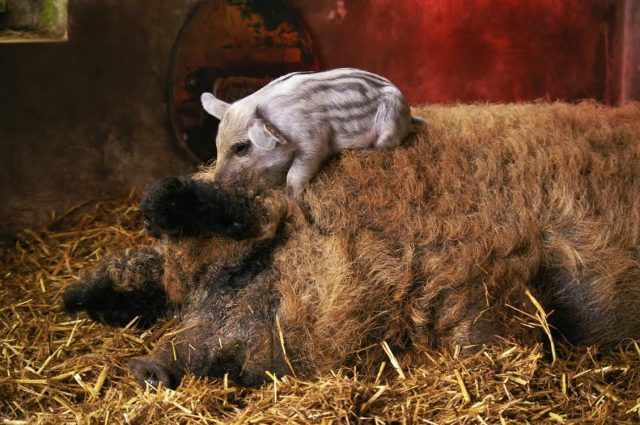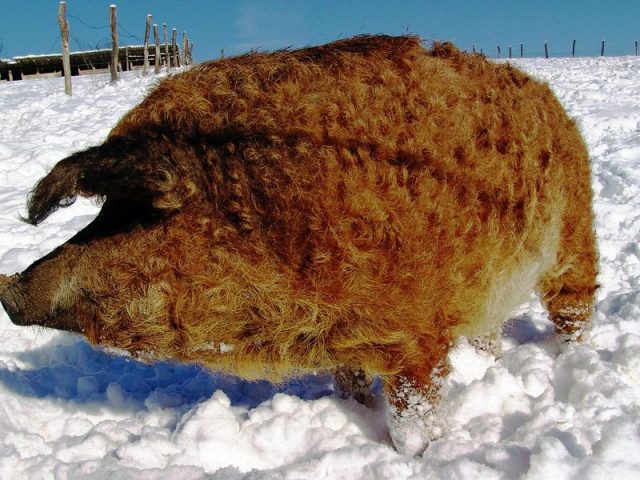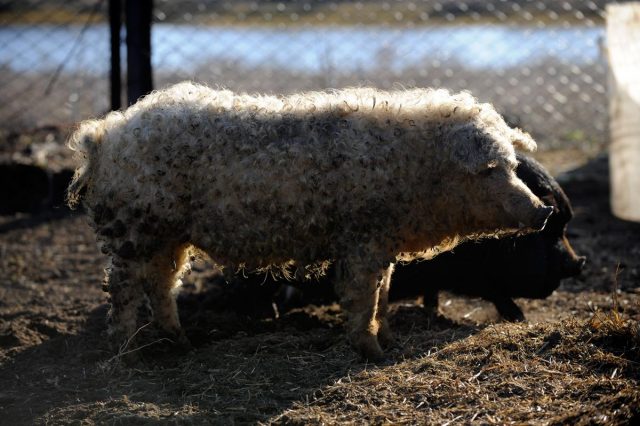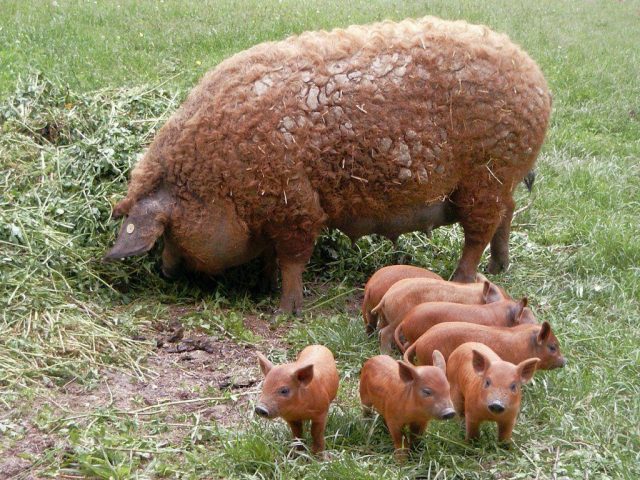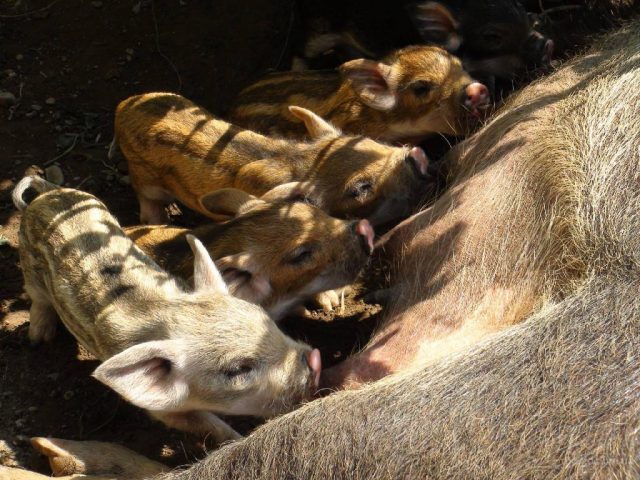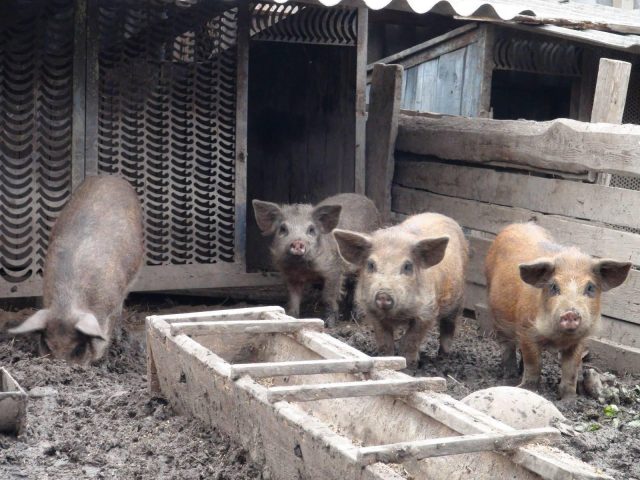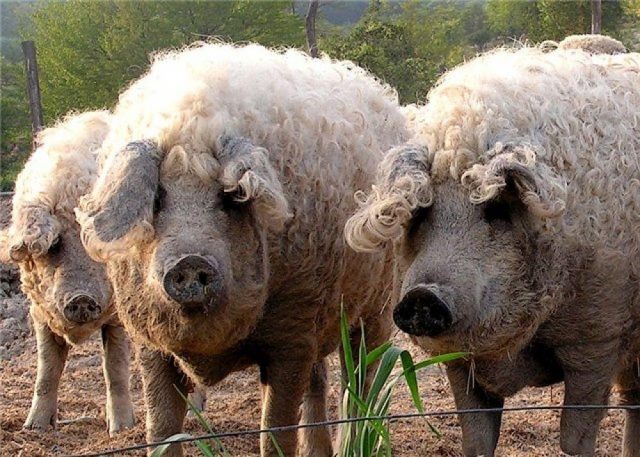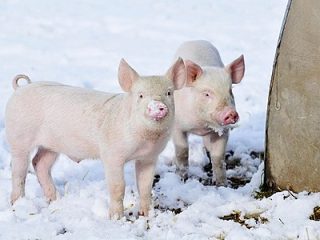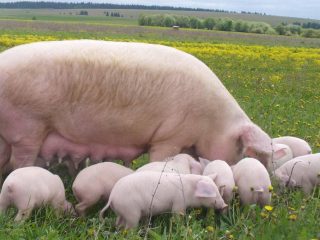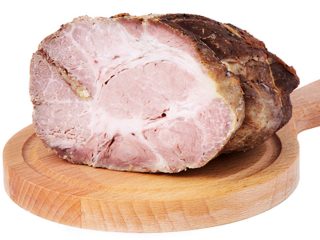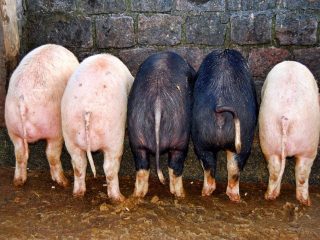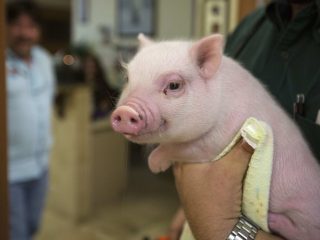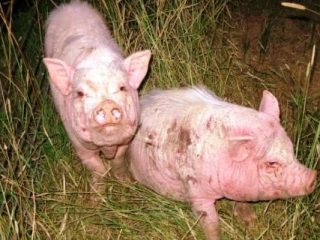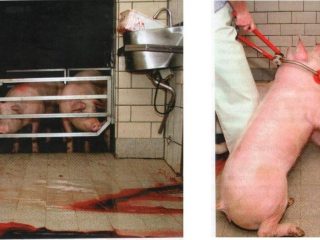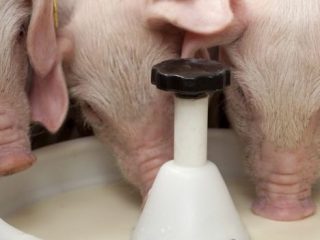Content
Mangal pigs attract attention with their unusual appearance. They have thick, curly fur, allowing them to spend the winter outside. In Russia the breed is very rare and highly valued among farmers.
What kind of breed is this “Mangal”
As can be seen in the photo, Mangal pigs are distinguished by an unusual appearance, but the main feature of the breed is considered to be high productivity and a thin layer of grease, which makes pig products particularly expensive. Mangal pigs belong to the meat breed.
History of the creation and preservation of the breed
The Mangal pig breed appeared in 1830 in Hungary. One of the Hungarian nobles, Duke Joseph, decided to cross domestic pigs with wild ones living in the Carpathians. The basis was taken from Mediterranean Sumadia pigs.
The Duke wanted to create a breed of pigs that would be maximally adapted to the climatic conditions of the area.The attempt was successful, and breeders developed a new breed of curly pigs that are immune to many diseases that affect domestic animals. These pigs could live outside at any time of the year and in any weather; they did not need a full-fledged pigsty. As for nutrition, the pigs had enough simple pasture.
Thanks to such significant advantages, the breed quickly became popular throughout the Austrian Empire and Ukrainian Transcarpathia. It was often bred in the farms of churches and monasteries. The breed received such high praise and recognition that in 1833 a law was passed that prohibited the crossing of Mangal pigs with other breeds.
When World War II ended, Mangal pigs were on the verge of extinction. The authorities of Hungary and Ukraine considered the breed useless, and almost all the pigs were put under the knife. By the beginning of the 1970s of the 20th century. There are only about 200 Mangal pigs left. However, already in the 80s of the same century, the Hungarian authorities launched a program to restore this valuable breed, to which at the beginning of the 21st century. Austria, America and Britain joined. Somewhat later, Russia and Ukraine began to import these pigs.
What kind of meat does Mangal pig have?
“Marbled” meat from Mangal pigs is juicy and tasty. It is many times more tender than the meat of pigs of other breeds and has practically no fatty layers. The carcass contains about 70 - 80% meat. That is why Mangal meat is characterized by high consumer value.
Characteristics of Mangal pigs
As you can see from the photo, Mangal pigs are distinguished by long, thick hair that curls into small rings. Wool is somewhat reminiscent of sheep's wool, it is soft and pleasant to the touch. In Hungary, a pig of this breed is also called a “curly pig”, in England – a “sheep-pig”, and in Russia – a “Hungarian Mangalitsa downy pig”.
Mangalitsa's fur is thickest in winter, this protects them from severe frosts. In the spring, the animals' hair becomes thinner, and pigs develop black stripes on their backs, characteristic of the wild ancestors of wild boars. Piglets are also born with stripes on their backs. If you constantly keep Mangal pigs in a warm pigsty, the wool necessary to adapt to frost will practically disappear.
There are 4 known color varieties of Mangal pigs: swallow, white, red and black. About 80% of the total livestock are white pigs. Red pigs are characterized by the highest productivity, they were bred by crossing white pigs with the Szalontai breed. Swallow pigs were bred by crossing white pigs with the Sirius breed, which is characterized by a larger build.
Description and photo of the Mangal pig breed:
- animals have medium-sized ears, strong, thin limbs;
- distinguished by thick, curly hair;
- the live weight of a sow can reach 160 - 200 kg;
- wild boars, as a rule, weigh about 200 - 300 kg;
- They have a strong constitution and a strong skeleton.
Photos of Mangalov pigs:
Photos of Mangalov piglets:
Advantages and disadvantages
Advantages of the Mangal pig breed:
- low maintenance requirements;
- early onset of puberty;
- high percentage of meat content (70 - 80%);
- excellent taste of meat products;
- inexpensive feed;
- resistance to low temperatures;
- immunity to many diseases.
Disadvantages of the Mangal pig breed:
- a rare breed for Russia;
- high cost of pigs and piglets;
- the need for keeping in semi-wild conditions (walking);
- when overfed, animals are prone to obesity, which reduces the quality of the resulting meat products;
Cost of Mongolian pigs and piglets
Since Mongolian pigs are considered rare animals in Russia, their price is quite high. On average, Mongolian piglets are sold for 12 - 20 thousand rubles. That is why breeding Hungarian downy pigs is an extremely profitable business.
How to determine the authenticity of Mangal piglets
When purchasing piglets, it is important to pay attention to the purity of the breed. To verify the authenticity of the animal, you can ask the seller for a certificate that confirms the pedigree.
You should buy piglets only from trusted pig farms. It is advisable to ask the seller to show the parents of the pig before purchasing: in this way, the risk of purchasing a non-purebred pig can be minimized.
Features of keeping pigs Brazier
Mangal pigs are semi-wild: in the summer they are able to feed on pasture on their own. Reviews from farmers indicate that caring for Mangal pigs is not particularly difficult, but maintaining them may require a spacious walking area.
Despite the fact that Mangals can be kept outside all year round, in winter it is still advisable for them to take shelter from severe frosts, especially for small piglets. Therefore, in addition to the walking area, you will also need to build a pigsty.
Feeding Mongolian pigs and piglets
Mongolian pigs are unpretentious in feeding; the animals are omnivores, so they do not require large amounts of feed. If the pig’s body receives enough nutrients, it will be able to increase its weight by more than 600 g per day.
To ensure an increase in muscle mass in a short time, Mangal pigs should eat a lot of greens. In the summer, they regulate their own nutrition and diet, but in winter, the animals’ food must contain vegetables, grain and hay. Ideally, 70% of the diet should consist of root vegetables, corn tops and forbs hay, and 30% should be acorns and chestnuts.
Piglets are taught to forage at an early age. To do this, you can send them out for a walk with the sow. If walking pigs in the summer is not possible, you will also have to prepare food for them.
The introduction of grain crops into the diet will help accelerate the growth of piglets. Vegetables in the food can include carrots, pumpkin, zucchini, potatoes and beets. In addition to vegetables, pigs can also eat fruits. Vegetables and fruits are grated and only then given to animals.
Newborn piglets of the Mangal breed need complementary feeding starting from the 3rd - 5th day of life. At first, they can be fed little by little with liquid mash and roasted barley grains.It will also be useful to introduce chalk, clay and bone meal into the diet. Upon reaching three weeks of age, piglets can eat exactly the same as adult animals.
When Mangal pigs reach a weight of 150 kg, it is important to diversify their diet and ensure a balanced diet. Lack of nutrients can completely stunt a pig's growth. It is also extremely important for pigs to have free access to fresh, clean water.
Vaccination
Mangal pigs are famous for their strong immunity, but they can still be affected by diseases such as distemper, encephalitis, erysipelas, foot and mouth disease, ascariasis, and leptospirosis.
To prevent the development of these diseases, it is necessary to vaccinate animals. Timely vaccination will ensure the health of the entire pig population and other inhabitants of the farm.
Caring for Mangal pigs and piglets
If Mangal piglets are fattened for slaughter, castration of the animals is mandatory at the age of 1 - 1.5 months. After this procedure, the weight of the animals, as a rule, begins to increase.
The room for keeping Brazier pigs should be large. The area should be calculated based on the fact that one pig needs about 5 square meters for a comfortable existence. m.
If there are few pigs, when laying the floor in the pigsty, they usually make an earthen mound, which is covered with boards on top. If the livestock is large, the best option would be to use a concrete slot covering. When laying the floor, it is also important to think about the construction of gutters to remove waste products.
Ventilation in the room should be good. Lighting is also important: if there is too much light, pigs can become restless.Organizing a water supply in the pigsty will greatly simplify cleaning.
Arrangement of a walking area
Mangal pigs are quite large, so the area for their walking should be spacious. The territory must be fenced with a strong and stable fence that can withstand the onslaught of pigs and does not allow predators to enter. If you equip a walking area under a canopy, pigs will be able to hide under it from the wind and precipitation.
It is extremely important to clear the walking area of poisonous plants in advance. The area needs to be planted with grass; small shrubs are also suitable. There should be enough plant food for animals; it is the main source of energy for pigs.
Breeding Features
Sows of the Mangal breed reach sexual maturity at the age of 5 - 7 months. However, it is not recommended to breed animals weighing less than 100 kg. During one pregnancy, a sow can give birth to 12-16 piglets. Lack of body weight will negatively affect the offspring; they may be born weak or non-viable.
The duration of pregnancy for sows is 112 - 120 days. Sows are able to cope with farrowing on their own. Piglets grow up quite quickly, and by the time they reach the age of one month, they become independent from the sow. The sow becomes ready for repeated mating 5 to 7 days after the piglets have been weaned. This allows you to get 2 litters per year.
Conclusion
Mangal pigs are semi-wild animals that do not require much care. Almost any food, including pasture, is suitable for them as food, and for maintenance they will need to build a pigsty and a walking area.Breeding Mangals is a profitable business, since the animals are highly valued among farmers and quickly gain large weight.
